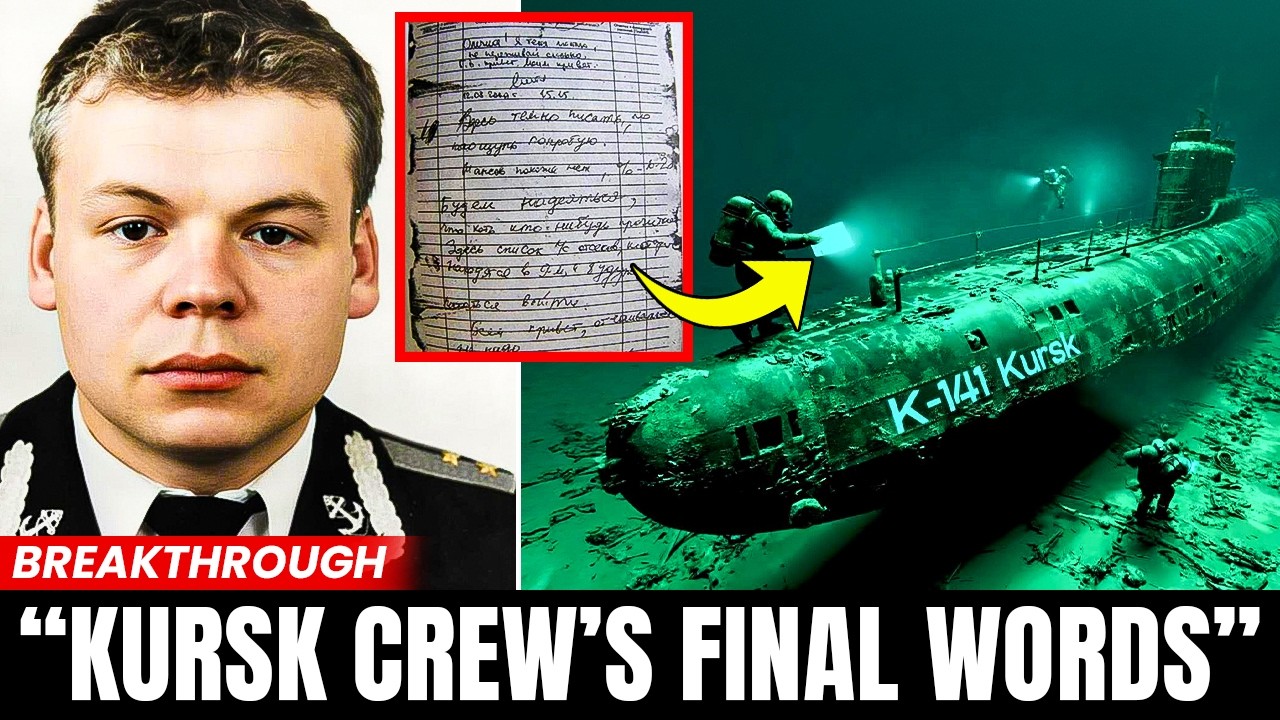Trapped in the Dark: The Haunting Final Words of the Kursk Submarine Crew
Imagine being sealed in a metal tomb, 350 feet under the icy Barents Sea, with only flickering hope and a pen to leave your final thoughts. In 2000, the Kursk submarine sank, taking 118 lives—but a letter found in a sailor’s pocket revealed a truth so chilling it shook the world. What did the crew write in their final hours? Why did help arrive too late? 💔 Click to uncover the heartbreaking story behind one of Russia’s darkest naval tragedies:

On August 12, 2000, the Russian nuclear submarine K-141 Kursk sank to the bottom of the Barents Sea, claiming the lives of all 118 crew members in one of the most devastating naval disasters in modern history. A haunting letter found on the body of Lieutenant-Captain Dmitri Kolesnikov revealed the desperate final hours of 23 survivors, shattering official claims and exposing systemic failures. This article explores the disaster, the contents of Kolesnikov’s letter, the mishandled rescue efforts, and the lasting impact on Russia and beyond, critically examining the narrative to uncover the truth beneath the tragedy.
The Kursk: Pride of the Russian Navy
The Kursk, an Oscar II-class nuclear submarine, was a symbol of Russia’s post-Soviet naval prowess. Measuring 508 feet long and powered by two OK-650 nuclear reactors, it was designed to counter U.S. aircraft carrier groups with its 24 P-700 Granit missiles and Type 65 torpedoes, capable of carrying nuclear warheads. Its crew, led by Captain Gennady Lyachin, had recently been honored as the best in the Northern Fleet, a testament to their skill and readiness. On August 10, 2000, the Kursk set sail for the “Summer-X” exercise, the Russian Navy’s first large-scale naval maneuver in over a decade, involving over 50 ships, submarines, and 80 aircraft.
The submarine was equipped with a full combat load, including practice torpedoes with no explosive warheads. These dummy torpedoes, however, were manufactured to lower standards, a detail that would prove catastrophic. On the morning of August 12, at 11:28 local time, the Kursk was preparing to fire a torpedo at the Kirov-class battlecruiser Pyotr Velikiy when disaster struck.
The Catastrophe Unfolds
At 11:28 a.m., a muffled explosion rocked the Kursk’s forward torpedo room, followed two minutes later by a second, far more powerful blast, equivalent to 100–250 kilograms of TNT and registering 4.2 on the Richter scale, detectable as far as Alaska. The official Russian investigation concluded that a faulty weld in a hydrogen peroxide-fueled (HTP) Type 65 torpedo caused a leak, igniting kerosene fuel and triggering the initial explosion. The second blast, likely from the detonation of multiple torpedoes, tore a massive hole in the bow, sending the submarine plummeting 108 meters to the seabed.
While the explosions killed most of the 118 crew instantly, 23 survivors, including Lieutenant-Captain Dmitri Kolesnikov, managed to retreat to the ninth compartment, a rear section of the submarine. Here, in pitch-black darkness, Kolesnikov penned a letter that would later reveal the harrowing reality of their final hours.
The Letter: A Cry from the Deep
Kolesnikov’s note, found in his pocket when his body was recovered in October 2000, offered a grim glimpse into the survivors’ fate. Written between 1:34 p.m. and 3:15 p.m. on August 12, the letter stated: “All personnel from sections six, seven, and eight have moved to section nine. There are 23 of us here. We have made this decision because none of us can escape.” The note, initially legible, became a scrawl, ending with the words, “I am writing blind,” as power failed and darkness enveloped the compartment.
The letter revealed that at least 23 crew members survived the initial blasts, contradicting early Russian Navy claims that all had perished instantly. Kolesnikov noted attempts by two or three sailors to use the escape hatch, but the mechanism was likely damaged or the men too injured to operate it. The survivors faced suffocation, hypothermia, or carbon monoxide poisoning as a fire, possibly sparked by a chemical oxygen cartridge falling into oily seawater, consumed the remaining oxygen. Experts estimate the men survived six to eight hours, though some speculate they could have lasted up to three days.
The letter’s personal elements were deemed too sensitive for public release, but its official details reignited debate over whether a faster rescue could have saved lives. Kolesnikov’s widow, Olga, expressed her grief: “I had a feeling he was alive and I felt a pain. Now I see that there was a reason for this pain.” The note not only humanized the tragedy but also exposed the Russian government’s mishandling of the crisis.
A Botched Rescue and Official Denials
The Russian Navy’s response was slow and disorganized. Northern Fleet commander Admiral Vyacheslav Popov waited nine hours after the sinking to order a search and 12 hours to inform the Kremlin. President Vladimir Putin, then in his first term, was vacationing on the Black Sea and did not return to Moscow for nine days, drawing widespread criticism for his apparent indifference. The Navy initially downplayed the incident, with Popov even praising the exercise’s success while rumors of the disaster spread among crew families.
Offers of assistance from Britain, Norway, and the United States were refused for five days, as Russian mini-submarines made futile attempts to access the Kursk’s escape hatch. When Norwegian divers finally opened the hatch on August 21, they found the compartment flooded, confirming no survivors remained. Lawyer Boris Kuznetsov, representing 55 victims’ families, argued that the 12-hour delay in declaring an emergency and the rejection of foreign help cost critical time.
The official narrative faced skepticism. While the investigation pointed to a torpedo malfunction, some Russian officials, including Popov, insisted the Kursk collided with a NATO submarine, a claim unsupported by evidence. Vice-Admiral Valery Ryazantsev blamed inadequate training, poor maintenance, and outdated safety instructions, noting the crew’s lack of experience with HTP torpedoes. A 2002 summary of the 133-volume investigation, kept largely classified, cited “stunning breaches of discipline, shoddy, obsolete, and poorly maintained equipment,” alongside “negligence, incompetence, and mismanagement.”
The Aftermath and Legacy
In October 2001, a Dutch-led consortium raised the Kursk from the seabed in a £44 million operation, recovering 115 of the 118 bodies. The bow, where the explosions occurred, was left on the seafloor, and the wreckage was moved to Sayda Bay for storage. Families received compensation, including apartments and 720,000 rubles (over $20,000), a rare gesture from the Russian government.
The disaster left a profound mark on Russia. It shattered public confidence in the military and Putin’s leadership, with media comparing the government’s secrecy to the Chernobyl cover-up. The tragedy inspired songs, films, and books, including “Captain Kolesnikov” by DDT and the 2018 film Kursk: The Last Mission. For the families, the pain endures. Kristina, daughter of sailor Sergey Erakhtin, spoke of her father as a hero who remains “somewhere nearby, guarding me.”
A Critical Reflection
The Kursk disaster raises unsettling questions about accountability and transparency. The Russian Navy’s insistence on a collision theory, despite evidence pointing to internal failures, suggests an attempt to deflect blame. The classified 133-volume report, with only a four-page summary released, fuels speculation of a cover-up. Why was foreign aid delayed? Could lives have been saved with a swifter response? The survivors’ desperate wait in the ninth compartment underscores the human cost of bureaucratic pride and secrecy.
The tragedy also highlights the dangers of military hubris. The Kursk’s advanced technology could not compensate for neglected maintenance and inadequate training. Globally, the incident spurred cooperation in submarine rescue operations, emphasizing the need for preparedness in naval operations. Yet, 25 years later, the Kursk remains a symbol of loss and a reminder that truth is often the first casualty in a crisis.
Conclusion
The Kursk submarine disaster was more than a naval accident; it was a national and human tragedy that exposed systemic flaws and governmental failures. Kolesnikov’s letter, written in darkness, stands as a testament to the crew’s courage and a haunting indictment of the delays that sealed their fate. As we reflect on this catastrophe, we must ask: What lessons have been learned, and how can we ensure such a loss is never repeated? The Kursk’s legacy endures in the grief of families, the reforms it prompted, and the questions it left unanswered.





